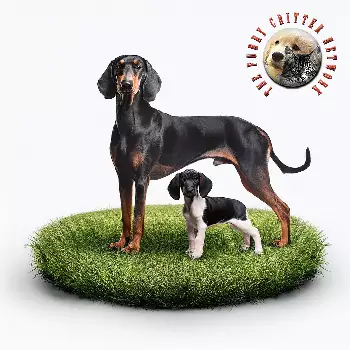The Black Forest Hound is generally a healthy, hardy breed with a typical lifespan of 12 to 13 years when provided with appropriate care, nutrition, and exercise. Their development as working dogs subjected to natural selection pressures created populations where soundness and good health were essential for performing demanding hunting work. However, as with all breeds, certain health conditions can affect individuals, and responsible owners should understand these potential issues.
Hip dysplasia occurs in some individuals, though comprehensive health data for this relatively rare breed remains limited. This developmental condition involves malformation of the hip joint, potentially causing pain, lameness, and arthritis. Severity ranges from mild cases causing minimal symptoms to severe dysplasia requiring surgical intervention. Maintaining healthy weight throughout life reduces stress on joints and minimizes symptoms in affected dogs. Responsible breeders screen breeding stock through radiographic evaluation.
Ear infections represent common health concerns for dogs with long, floppy ears that restrict air circulation and trap moisture. Signs include head shaking, ear scratching, odor, discharge, or redness inside the ear. Regular ear cleaning and inspection help prevent infections, particularly important for hunting dogs who work in fields and wooded areas. Prompt veterinary treatment prevents acute infections from becoming chronic problems that damage ear structures.
Eye problems may affect some individuals, though specific inherited eye diseases haven't been extensively documented in this breed. Regular veterinary examinations can detect issues like cataracts or other conditions before they significantly impact vision or quality of life. Early detection allows for appropriate management and treatment when available.
Patellar luxation occasionally affects dogs, occurring when the kneecap slips out of its normal position in the groove of the femur. Severity ranges from occasional luxation causing temporary limping to severe cases requiring surgical correction. Maintaining healthy weight and providing appropriate exercise on safe surfaces helps reduce risk. Regular veterinary examinations can detect developing problems before they become severe.
Dental disease poses risk for all dogs, including this breed. Without proper care, plaque accumulates, leading to tartar buildup, gum disease, tooth loss, and systemic infections affecting overall health. Regular tooth brushing combined with professional dental cleanings when necessary helps prevent serious dental problems. Dental disease prevention should begin early and continue throughout life.
Injuries sustained during hunting or vigorous outdoor activities can occur, including cuts, punctures, sprains, or more serious trauma. The breed's courage and determination sometimes lead them into hazardous situations while pursuing game. Checking dogs thoroughly after outdoor adventures and addressing injuries promptly prevents complications. First aid knowledge specific to hunting dogs benefits owners of active individuals.
Parasites pose health risks that require consistent preventive measures. Monthly heartworm preventive protects against this potentially fatal disease transmitted by mosquitoes. Flea and tick preventives protect against external parasites that cause discomfort and transmit diseases. Dogs who hunt or spend extensive time outdoors face higher parasite exposure and particularly benefit from comprehensive preventive programs. Internal parasite screening and deworming according to veterinary recommendations maintain digestive system health.
Regular veterinary care forms the foundation of preventive health maintenance. Annual wellness examinations allow veterinarians to detect health problems early when treatment is most effective and less costly. Puppies require a series of vaccinations against infectious diseases, followed by regular boosters throughout life according to veterinary recommendations. Core vaccines protect against distemper, parvovirus, hepatitis, and rabies. Additional vaccines may be recommended based on lifestyle and exposure risk.
Nutrition plays vital roles in maintaining health and preventing disease. High-quality dog food appropriate for the dog's age, activity level, and health status provides essential nutrients. Active hunting dogs have significantly different nutritional needs than sedentary companions. Working with veterinarians to establish appropriate feeding programs ensures dogs receive proper nutrition throughout their lives.
Weight management is crucial for health and longevity. Obesity stresses joints, increases disease risk, and shortens lifespan. These athletic dogs should maintain lean condition with easily felt ribs and visible waist when viewed from above. Feeding appropriate portions and providing regular vigorous exercise maintains ideal weight throughout life.
Genetic health data for this breed remains limited compared to more common breeds, as the small population and limited distribution restrict comprehensive health studies. Responsible breeders screen breeding stock for known hereditary conditions and work to maintain genetic diversity within the small breeding population. Prospective owners should ask breeders about health testing performed on breeding dogs and any health issues present in bloodlines.
Preventive care throughout life significantly impacts overall health and longevity. Beyond regular veterinary examinations and vaccinations, preventive measures include parasite control, dental care, appropriate nutrition, weight management, and adequate exercise. Dogs receiving comprehensive preventive care throughout life typically remain healthier and more active into their senior years.
Common Health Issues
- Hip dysplasia occurs in some individuals, though comprehensive health data for this relatively rare breed remains limited.
- Eye problems may affect some individuals, though specific inherited eye diseases haven't been extensively documented in this breed.
- Patellar luxation occasionally affects dogs, occurring when the kneecap slips out of its normal position in the groove of the femur.
- Dental disease poses risk for all dogs, including this breed.
- Dental disease prevention should begin early and continue throughout life.
Preventive Care & Health Monitoring
- The Black Forest Hound is generally a healthy, hardy breed with a typical lifespan of 12 to 13 years when provided with appropriate care, nutrition, and exercise.
- Regular veterinary examinations can detect issues like cataracts or other conditions before they significantly impact vision or quality of life.
- Maintaining healthy weight and providing appropriate exercise on safe surfaces helps reduce risk.
- Regular veterinary examinations can detect developing problems before they become severe.
Regular veterinary check-ups and preventive care are essential for maintaining your Black Forest Hound's health and longevity.

